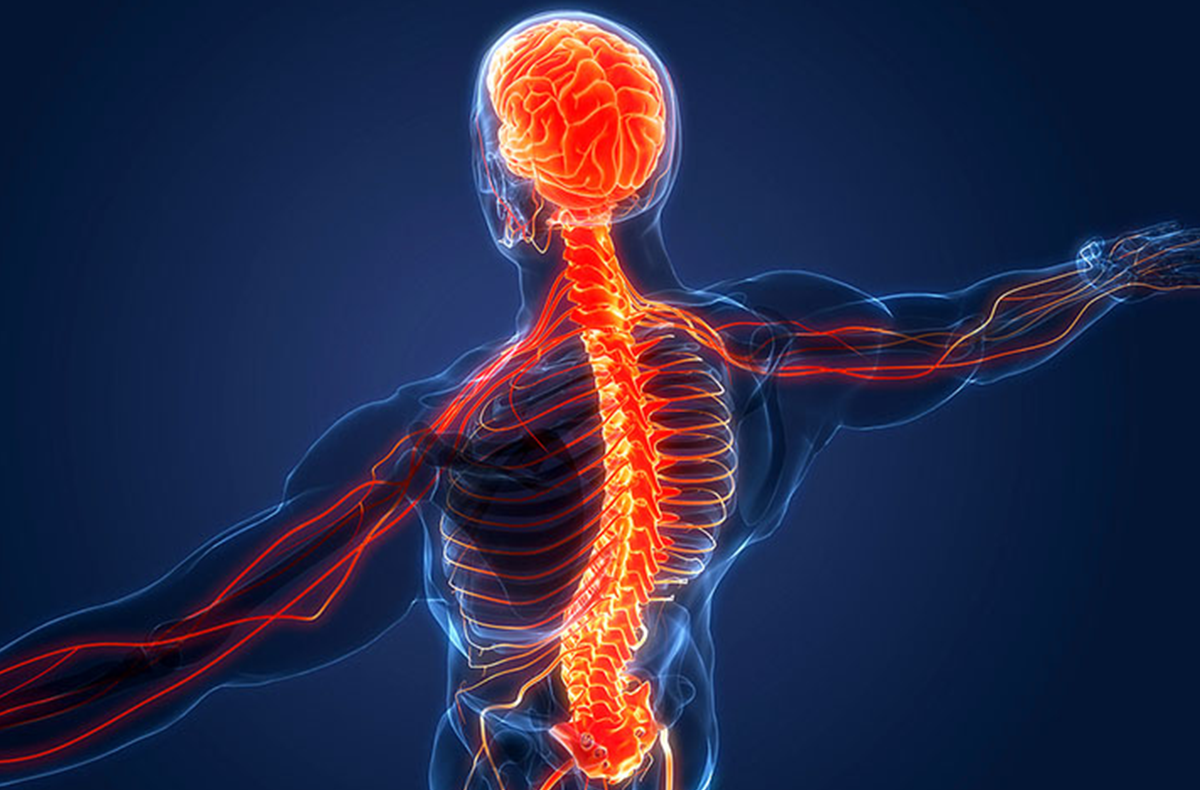In the gut there is a large network of nerve endings originating from the sympathetic and parasympathetic autonomic nervous system, especially the vagus nerve and spinal cord nerves, as well as an intrinsic neural network, called the enteric nervous system. These networks are interconnected. The vagus nerve is a cerebral nerve that runs down the neck and extends (or "wanders") virtually throughout the body, hence its name (not that it is a "lazy" nerve, as many people think). It is the main nerve of the parasympathetic system. At the intestinal level, it promotes the secretions of the digestive organs and the bowel movements that promote digestion and move the food bolus and faeces forward. It has about 20% of efferent fibres (carrying nerve messages from the brain to the gut) and 80% of afferent fibres (transmitting information from the gut to the brain). Thanks to this nerve, there is constant two-way communication between the brain and the gut. This communication takes place by means of chemicals (neurotransmitters, short-chain fatty acids, peptides, hormones, cytokines, etc.) that are released by the vagus nerve into the gut in the case of efferent information, or by the gut to the vagus nerve for the information to travel to the brain in the case of afferent messages. These chemicals can be produced both by nerve endings, intestinal or immune cells in the gut wall, and, to a large extent, by the microbiota. Thus, the microbiota plays a crucial role in gut-brain communication. I would like to clarify that the vagus nerve, while being the main communication pathway between the gut and the brain, is by no means the only one. Another important communication pathway is the blood pathway (hormones, cytokines or other chemicals produced in the brain travel to the gut via the blood, and vice versa). I won't go much further into the exciting world of the gut-brain axis, which would be enough to write several books, but, by way of example, I could say that it is more than proven that people suffering from psychiatric illnesses such as depression or anxiety, neurodegenerative diseases such as Alzheimer's or Parkinson's or neurodevelopmental disorders (autism spectrum disorders for example) often have a profound alteration of their gut microbiota, known as "dysbiosis". If you want to know more about gut microbiota, I recommend you read this article: The role of the gut and its microbiota. Gut-brain axis.
Bibliography:
Arponen S (2021). Es la microbiota, idiota. Alienta.
Godaly G, Ambite I, Svanborg C. Innate immunity and genetic determinants of urinary tract infection susceptibility. Curr Opin Infect Dis. 2015 Feb;28(1):88-96.
Lacerda Mariano L, Ingersoll MA. Bladder resident macrophages: Mucosal sentinels. Cell Immunol. 2018 Aug;330:136-141.
Song J, Abraham SN. TLR-mediated immune responses in the urinary tract. Curr Opin Microbiol. 2008 Feb;11(1):66-73.
Becknell B, Ching C, Spencer JD. The Responses of the Ribonuclease A Superfamily to Urinary Tract Infection. Front Immunol. 2019 Nov 29;10:2786.
Steigedal M, Marstad A, Haug M, Damås JK, Strong RK, et al. Lipocalin 2 imparts selective pressure on bacterial growth in the bladder and is elevated in women with urinary tract infection. J Immunol. 2014 Dec 15;193(12):6081-9.
Ueda N, Kondo M, Takezawa K, Kiuchi H, Sekii Y, et al. Bladder urothelium converts bacterial lipopolysaccharide information into neural signaling via an ATP-mediated pathway to enhance the micturition reflex for rapid defense. Sci Rep. 2020 Dec 3;10(1):21167.
Hayes BW, Abraham SN. Innate Immune Responses to Bladder Infection. Microbiol Spectr. 2016 Dec;4(6):10.1128/microbiolspec.UTI-0024-2016.
O’Brien VP, Hannan TJ, Schaeffer AJ, Hultgren SJ. Are you experienced? Understanding bladder innate immunity in the context of recurrent urinary tract infection. Curr Opin Infect Dis. 2015 Feb;28(1):97-105.
Huang J, Fu L, Huang J, Zhao J, Zhang X, et al. Group 3 Innate Lymphoid Cells Protect the Host from the Uropathogenic Escherichia coli Infection in the Bladder. Adv Sci (Weinh). 2022 Feb;9(6):e2103303.
Wu J, Abraham SN. The Roles of T cells in Bladder Pathologies. Trends Immunol. 2021 Mar;42(3):248-260.
Billips BK, Schaeffer AJ, Klumpp DJ. Molecular basis of uropathogenic Escherichia coli evasion of the innate immune response in the bladder. Infect Immun. 2008 Sep;76(9):3891-900.
Nielsen KL, Stegger M, Kiil K, Godfrey PA, Feldgarden M, Lilje B, Andersen PS, Frimodt-Møller N. Whole-genome comparison of urinary pathogenic Escherichia coli and faecal isolates of UTI patients and healthy controls. Int J Med Microbiol. 2017 Dec;307(8):497-507.
Ambite I, Butler D, Wan MLY, Rosenblad T, Tran TH, Chao SM, Svanborg C. Molecular determinants of disease severity in urinary tract infection. Nat Rev Urol. 2021 Aug;18(8):468-486.
Ziegler T, Jacobsohn N, Fünfstück R. Correlation between blood group phenotype and virulence properties of Escherichia coli in patients with chronic urinary tract infection. Int J Antimicrob Agents. 2004 Sep;24 Suppl 1:S70-5.
Sulaiman KA, Al Qahtani N, Al Muqrin M, Al Dossari M, Al Wabel A, et al. The correlation between non-O blood group type and recurrent catheter-associated urinary tract infections in critically ill patients: A retrospective study. J Int Med Res. 2022 Jul;50(7):3000605221108082.
Albracht CD, Hreha TN, Hunstad DA. Sex effects in pyelonephritis. Pediatr Nephrol. 2021 Mar;36(3):507-515.
Wnorowska U, Piktel E, Deptuła P, Wollny T, Król G, et al. Ceragenin CSA-13 displays high antibacterial efficiency in a mouse model of urinary tract infection. Sci Rep. 2022 Nov 10;12(1):19164.

